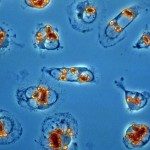Link to Pubmed [PMID] – 10394922
Mol Gen Genet 1999 Jun; 261(4-5): 841-50
Enological strains of Saccharomyces cerevisiae display a high level of chromosome length polymorphism, but the molecular basis of this phenomenon has not yet been clearly defined. In order to gain further insight into the molecular mechanisms responsible for the karyotypic variability, we examined the chromosomal constitution of a strain known to possess aberrant chromosomes. Our data revealed that the strain carries four rearranged chromosomes resulting from two reciprocal translocations between chromosomes III and I, and chromosomes III and VII. The sizes of the chromosomal fragments exchanged through translocation range from 40 to 150 kb. Characterization of the breakpoints indicated that the translocations involved the RAHS of chromosome III, a transposition hot-spot on the right arm of chromosome I and a region on the left arm of chromosome VII. An analysis of the junctions showed that in all cases Ty elements were present and suggested that the translocations result from recombination between transposable Ty elements. The evidence for multiple translocations mediated by Ty elements in a single strain suggests that spontaneous Ty-driven rearrangement could be quite common and may play a major role in the alteration of karyotypes in natural and industrial yeasts.


